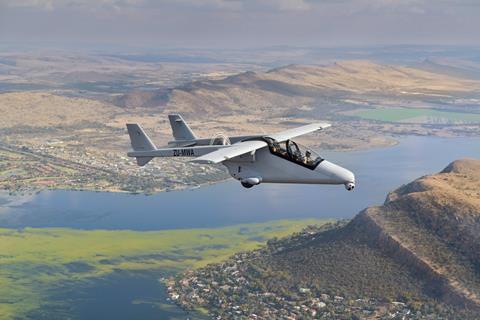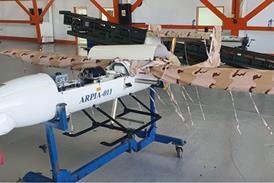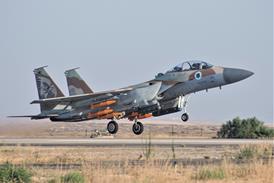Defence group Paramount will integrate weapons onto its Mwari light surveillance platform by early next year, as it steps up deliveries of the two-crew, single-pusher turboprop to initial operators Mozambique and the Democratic Republic of the Congo (DRC).

Mozambique – the previously undisclosed launch customer – took delivery of the first Mwari in December 2022 and has accrued more than 70h of flying time in “challenging reconnaissance and surveillance assignments”, says Paramount.
The DRC was recently announced as the second operator of the type. Paramount says it has delivered a total of three aircraft to the two countries, and has a production backlog of six, three of which will be handed over in 2024 to the current customers – it does not reveal the split.
Paramount says weapons testing and certification will start early in the first quarter. The Pratt & Whitney Canada PT6A-66-powered Mwari has a payload of 800kg (1,760lb) and is fitted with three hardpoints on each wing. The company says it will disclose details about the weapons “at a later date”.
Paramount, founded in South Africa by entrepreneur Ivor Ichikowitz in 1994, acquired full rights to the Mwari from its father and son developers in 2019, and flew the production-standard aircraft for the first time in 2022.
The type, intended as a more affordable reconnaissance and light attack solution than Western counterparts for many developing countries, is produced at a new factory at Wonderboom airport, near Pretoria.
Paramount – which produces a range of defence products and is best known for its armoured vehicles – is now headquartered in Abu Dhabi, but has production and maintenance operations in Kazakhstan, India, South Africa and the USA.
Interviewed at the DSEI defence show in London on 20 September, chief executive Steve Griessel said the company’s “portable production” philosophy – with 90% of parts manufactured in-house – means the Mwari can be assembled “almost anywhere”.
He expects output of the aircraft to increase to around five aircraft per year by 2025, and to be producing the Mwari “in at least three countries” by the end of the decade.
“The way the aircraft is designed makes it perfect for portable production,” he says. “The intention is to make the technology available to other governments, something we already do in India and Kazakhstan in the land vehicle world.”
He adds: “All governments have the imperative to drive domestic jobs, and we realise that in order to play in this market you have to be able to do this. We are not walking away from South Africa, but it’s our test kitchen.”
The Mwari – which translates in the southern African Shona language as all-seeing being – has a crew of two: a pilot and weapons/surveillance systems operator. However, the angled, tandem, dual-control cockpit means the aircraft can also be used for training.
Paramount – through partners Leidos and Vertex Aerospace – last year pitched an International Traffic in Arms Regulations (ITAR)-compliant version of the Mwari, dubbed the Bronco II, for the US Special Operations Command’s Armed Overwatch contest that was seeking around 75 aircraft for close air support, precision strike, and intelligence, surveillance and reconnaissance missions.
Although the bid lost to the Air Tractor/L3Harris AT-802U Sky Warden, Griessel says the variant is still on the market. However, he admits “the vast majority of customers will want the non-ITAR aircraft”.
Paramount’s other aerospace businesses include a US subsidiary in Fort Worth that carries out Dassault Mirage F1 maintenance support to two companies that provide aggressor training to the US Air Force, and a military pilot training centre in South Africa.
The company is also beginning production of its N-Raven loitering munition, and in May announced a deal with Hellenic Defence Systems to manufacture the technology in Greece. Paramount says it has developed all the elements of the weapon in-house, including the seeker, the GPS system and artificial intelligence software.
At DSEI, Paramount published a report that estimates that the Russian-Ukraine conflict is driving a more than 500 per cent increase in the market for loitering munitions between 2020 and 2024, with annual spending on the capability exceeding $600 million.
“Our report underscores the need for agile, adaptable solutions,” says Griessel, who describes the N-Raven as a “fully-fledged technology transfer platform [that] can be produced domestically within a year”.
























